JANUARY
GURU GOVIND SINGH JAYANTI | Where: Patna Sahib, Patna
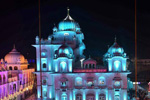 Guru Govind Singh Jayanti is celebrated in the memory of 10th Guru of Sikkh Community.
Guru Govind Singh Jayanti is celebrated in the memory of 10th Guru of Sikkh Community.
MAKARSANKRANTI | Where: All over Bihar
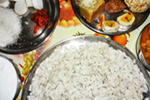 It marks the first day of sun's transit into the Makara (Capricorn), marking the
end of the month with the winter solstice and the start of longer days.
It marks the first day of sun's transit into the Makara (Capricorn), marking the
end of the month with the winter solstice and the start of longer days.
REPUBLIC DAY | When & Where: 26th January | All over Bihar
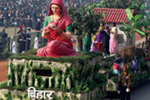 Republic Day honours the date on which the Constitution of India came into effect
on 26 January 1950 replacing the Government of India Act (1935) as the governing
document of India.
Republic Day honours the date on which the Constitution of India came into effect
on 26 January 1950 replacing the Government of India Act (1935) as the governing
document of India.
FEBRUARY
BASANT PUNCHAMI | Where: All over Bihar
 Vasant Panchami is the festival dedicated to goddess Saraswati who is their ancient
goddess of knowledge, language, music and all arts.She is the energy of Brahma,
and she symbolizes creative energy and power in all its form, including longing
and love (kama). The season and festival also reflects the agricultural fields which
are ripening with yellow flowers of mustard crop, which Hindus associate with Saraswati's
favorite color. People dress in yellow saris or shirts or accessories, share yellow
colored snacks and sweets. Some add saffron to their rice then eat yellow cooked
rice as a part of an elaborate feast.
Vasant Panchami is the festival dedicated to goddess Saraswati who is their ancient
goddess of knowledge, language, music and all arts.She is the energy of Brahma,
and she symbolizes creative energy and power in all its form, including longing
and love (kama). The season and festival also reflects the agricultural fields which
are ripening with yellow flowers of mustard crop, which Hindus associate with Saraswati's
favorite color. People dress in yellow saris or shirts or accessories, share yellow
colored snacks and sweets. Some add saffron to their rice then eat yellow cooked
rice as a part of an elaborate feast.
MARCH
MAHASHIVARATRI | Where: All over Bihar
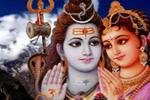 Maha Shivaratri a Hindu festival celebrated annually in honour of the god Shiva.
There is a Shivaratri in every luni-solar month of the Hindu calendar, on the month's
13th night/14th day, but once a year in late winter (February/March, or Phalguna)
and before the arrival of Summer, marks Maha Shivaratri which means "the Great Night
of Shiva".
Maha Shivaratri a Hindu festival celebrated annually in honour of the god Shiva.
There is a Shivaratri in every luni-solar month of the Hindu calendar, on the month's
13th night/14th day, but once a year in late winter (February/March, or Phalguna)
and before the arrival of Summer, marks Maha Shivaratri which means "the Great Night
of Shiva".
HOLI | Where: All over Bihar
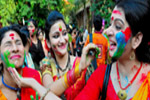 The Holi, also known as the "festival of colours", is an
Indian spring festival celebrated all across the Indian subcontinent. It signifies
the victory of good over evil, the arrival of spring, end of winter, and for many
a festive day to meet others, play and laugh, forget and forgive, and repair broken
relationships.
The Holi, also known as the "festival of colours", is an
Indian spring festival celebrated all across the Indian subcontinent. It signifies
the victory of good over evil, the arrival of spring, end of winter, and for many
a festive day to meet others, play and laugh, forget and forgive, and repair broken
relationships.
GOOD FRIDAY | Where: All over Bihar
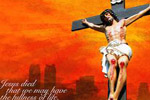 Good Friday is a Christian holiday commemorating the crucifixion of Jesus Christ
and his death at Calvary. It is observed during Holy Week as part of the Paschal
Triduum on the Friday preceding Easter Sunday, and may coincide with the Jewish
observance of Passover. It is also known as Holy Friday, Great Friday, and Black
Friday.
Good Friday is a Christian holiday commemorating the crucifixion of Jesus Christ
and his death at Calvary. It is observed during Holy Week as part of the Paschal
Triduum on the Friday preceding Easter Sunday, and may coincide with the Jewish
observance of Passover. It is also known as Holy Friday, Great Friday, and Black
Friday.
APRIL
BHIM RAO AMBEDKAR JAYANTI | When & Where: 14th April | All over Bihar
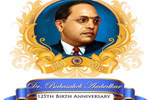 Bhimrao Ramji Ambedkar (14 April 1891 – 6 December 1956), popularly known as Baba
Saheb, was an Indian jurist, economist, politician and social reformer who inspired
the Dalit Buddhist Movement and campaigned against social discrimination against
Untouchables (Dalits), while also supporting the rights of women and labour. He
was Independent India's first law minister, the principal architect of the Constitution
of India and a founding father of the Republic of India.
Bhimrao Ramji Ambedkar (14 April 1891 – 6 December 1956), popularly known as Baba
Saheb, was an Indian jurist, economist, politician and social reformer who inspired
the Dalit Buddhist Movement and campaigned against social discrimination against
Untouchables (Dalits), while also supporting the rights of women and labour. He
was Independent India's first law minister, the principal architect of the Constitution
of India and a founding father of the Republic of India.
RAMNAVMI | Where: All over Bihar
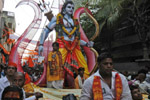 The Rama Navami (Devanagari: राम नवमी; IAST: Rāma navamī)
is a spring Hindu festival that celebrates the birthday of god Rama. He is particularly
important to the Vaishnavism tradition of Hinduism, as the seventh avatar of Vishnu.
The festival is a part of the spring Navratri, and falls on the ninth day of the
bright half (Shukla Paksha) in the Hindu calendar month of Chaitra. This typically
occurs in the Gregorian months of March or April every year. Rama Navami is a relatively
minor festival of Hinduism and not a national holiday, but an optional restricted
holiday in India.
The Rama Navami (Devanagari: राम नवमी; IAST: Rāma navamī)
is a spring Hindu festival that celebrates the birthday of god Rama. He is particularly
important to the Vaishnavism tradition of Hinduism, as the seventh avatar of Vishnu.
The festival is a part of the spring Navratri, and falls on the ninth day of the
bright half (Shukla Paksha) in the Hindu calendar month of Chaitra. This typically
occurs in the Gregorian months of March or April every year. Rama Navami is a relatively
minor festival of Hinduism and not a national holiday, but an optional restricted
holiday in India.
MAHAVEER JAYANTI | Where: All over Bihar
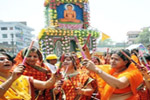 Mahaveer Janma Kalyanak, is one of the most important religious festival for Jains.
It celebrates the birth of Mahaveer, the twenty-fourth and last Tirthankara of Avasarpiṇī.
Mahaveer Janma Kalyanak, is one of the most important religious festival for Jains.
It celebrates the birth of Mahaveer, the twenty-fourth and last Tirthankara of Avasarpiṇī.
VEER KUNWAR SINGH JAYANTI | Where: All over Bihar
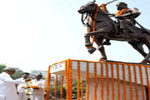 Kunwar Singh (1777 – 26 April 1858) was a notable leader during the Indian Rebellion
of 1857. He belonged to a royal Ujjainiya (Panwar) Rajput house of Jagdispur, currently
a part of Bhojpur district, Bihar, India. At the age of 80, he led a select band
of armed soldiers & the great lohtamia rajputs against the troops under the command
of the British East India Company. He was the chief organiser of the fight against
the British in Bihar. He is popularly known as Veer Kunwar Singh.
Kunwar Singh (1777 – 26 April 1858) was a notable leader during the Indian Rebellion
of 1857. He belonged to a royal Ujjainiya (Panwar) Rajput house of Jagdispur, currently
a part of Bhojpur district, Bihar, India. At the age of 80, he led a select band
of armed soldiers & the great lohtamia rajputs against the troops under the command
of the British East India Company. He was the chief organiser of the fight against
the British in Bihar. He is popularly known as Veer Kunwar Singh.
MAY
LABOUR DAY | When & Where: 1st May | All over Bihar
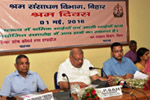 Labour Day is an annual holiday to celebrate the achievements of workers. Labour
Day has its origins in the labour union movement, specifically the eight-hour day
movement, which advocated eight hours for work, eight hours for recreation, and
eight hours for rest.
Labour Day is an annual holiday to celebrate the achievements of workers. Labour
Day has its origins in the labour union movement, specifically the eight-hour day
movement, which advocated eight hours for work, eight hours for recreation, and
eight hours for rest.
JANAKI NAUMI | Where: Sitamarhi
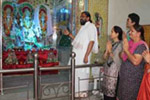 Sita Navami is celebrated as birth anniversary of Goddess Sita. This day is also
known as Sita Jayanti. Married women keep fast on Sita Navami day and pray to seek
long lives of their husbands. Sita Jayanti is celebrated on Navami Tithi during
Shukla Paksha of Vaishakha month. It is believed that Goddess Sita was born on Tuesday
in Pushya Nakshatra. Goddess Sita was married to Lord Rama who was also born on
Navami Tithi during Shukla Paksha of Chaitra month. On Hindu calendar Sita Jayanti
falls after one month of Rama Navami. Mata Sita is also known as Janaki as she was
the adopted daughter of King Janaka of Mithila. Hence this day is also known as
Janaki Navami. According to Hindu mythology, when King Janaka was ploughing the
land to conduct a Yajna he found a baby girl in the Golden casket. The Golden casket
was found inside the field while ploughing the land. A ploughed land is called Sita
hence King Janaka named the baby girl as Sita.
Sita Navami is celebrated as birth anniversary of Goddess Sita. This day is also
known as Sita Jayanti. Married women keep fast on Sita Navami day and pray to seek
long lives of their husbands. Sita Jayanti is celebrated on Navami Tithi during
Shukla Paksha of Vaishakha month. It is believed that Goddess Sita was born on Tuesday
in Pushya Nakshatra. Goddess Sita was married to Lord Rama who was also born on
Navami Tithi during Shukla Paksha of Chaitra month. On Hindu calendar Sita Jayanti
falls after one month of Rama Navami. Mata Sita is also known as Janaki as she was
the adopted daughter of King Janaka of Mithila. Hence this day is also known as
Janaki Navami. According to Hindu mythology, when King Janaka was ploughing the
land to conduct a Yajna he found a baby girl in the Golden casket. The Golden casket
was found inside the field while ploughing the land. A ploughed land is called Sita
hence King Janaka named the baby girl as Sita.
BUDDHA PURNIMA | Where: All over Bihar
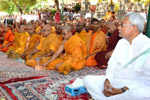 Vesak (Buddha Purnima, Buddha Jayanti) is a Buddhist festival that marks Gautama
Buddha's birth, enlightenment and death. It falls on the day of the full moon in
May and it is a gazetted holiday in India.
Vesak (Buddha Purnima, Buddha Jayanti) is a Buddhist festival that marks Gautama
Buddha's birth, enlightenment and death. It falls on the day of the full moon in
May and it is a gazetted holiday in India.
KABIR JAYANTI | Where: All over Bihar
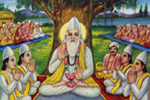 Sant Kabirdas (1440-1518 circa) was a famous poet, saint and social reformer of
India. His writings have greatly influenced the Bhakti movement. Kabir Panth which
is a religious community recognizes him as its founder and its members are known
as Kabir Panthis, the followers of Saint Kabirdas. His writings include Bijak, Sakhi
Granth, Kabir Granthawali and Anurag Sagar. The major part of Kabir's work was collected
by the fifth Sikh Guru, Guru Arjan Dev, and incorporated into the Sikh scripture
Guru Granth Sahib. The hallmark of Kabir's work consists of his two line couplets,
known as Kabir Ke Dohe. The birth anniversary of Sant Kabir is observed on Jyeshtha
Purnima as per Hindu lunar calendar.
Sant Kabirdas (1440-1518 circa) was a famous poet, saint and social reformer of
India. His writings have greatly influenced the Bhakti movement. Kabir Panth which
is a religious community recognizes him as its founder and its members are known
as Kabir Panthis, the followers of Saint Kabirdas. His writings include Bijak, Sakhi
Granth, Kabir Granthawali and Anurag Sagar. The major part of Kabir's work was collected
by the fifth Sikh Guru, Guru Arjan Dev, and incorporated into the Sikh scripture
Guru Granth Sahib. The hallmark of Kabir's work consists of his two line couplets,
known as Kabir Ke Dohe. The birth anniversary of Sant Kabir is observed on Jyeshtha
Purnima as per Hindu lunar calendar.
JUNE
SHAB E BARAT | Where: All over Bihar
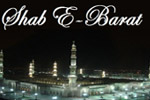 Shab E Barat or Mid-Sha'ban is a holiday observed by various Muslim communities
on the night between 14 and 15 Sha'ban. It is regarded as a night when the fortunes
of men for the coming year are decided and when Allah may forgive sinners. In many
regions, this is also a night when prayers are arranged for forgiveness from Allah
for one's deceased ancestors. Additionally, Twelver Shia Muslims commemorate the
birthday of Muhammad al-Mahdi on this date. Some Salafi streams oppose the recognition
of Mid-Sha'ban as exceptional.
Shab E Barat or Mid-Sha'ban is a holiday observed by various Muslim communities
on the night between 14 and 15 Sha'ban. It is regarded as a night when the fortunes
of men for the coming year are decided and when Allah may forgive sinners. In many
regions, this is also a night when prayers are arranged for forgiveness from Allah
for one's deceased ancestors. Additionally, Twelver Shia Muslims commemorate the
birthday of Muhammad al-Mahdi on this date. Some Salafi streams oppose the recognition
of Mid-Sha'ban as exceptional.
JULY
ID-UL-FITR | Where: All over Bihar
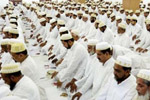 Eid al-Fitr, Malay "Lebaran", "feast of breaking the fast") is an important religious
holiday celebrated by Muslims worldwide that marks the end of Ramadan, the Islamic
holy month of fasting (sawm). This religious Eid (Muslim religious festival) is
the first and only day in the month of Shawwal during which Muslims are not permitted
to fast. The holiday celebrates the conclusion of the 29 or 30 days of dawn-to-sunset
fasting during the entire month of Ramadan. The day of Eid, therefore, falls on
the first day of the month of Shawwal. The date for the start of any lunar Hijri
month varies based on the observation of new moon by local religious authorities,
so the exact day of celebration varies by locality.
Eid al-Fitr, Malay "Lebaran", "feast of breaking the fast") is an important religious
holiday celebrated by Muslims worldwide that marks the end of Ramadan, the Islamic
holy month of fasting (sawm). This religious Eid (Muslim religious festival) is
the first and only day in the month of Shawwal during which Muslims are not permitted
to fast. The holiday celebrates the conclusion of the 29 or 30 days of dawn-to-sunset
fasting during the entire month of Ramadan. The day of Eid, therefore, falls on
the first day of the month of Shawwal. The date for the start of any lunar Hijri
month varies based on the observation of new moon by local religious authorities,
so the exact day of celebration varies by locality.
AUGUST
INDEPENDENCE DAY | When & Where: 15th August | All over Bihar
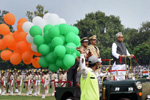 Independence Day is annually celebrated on 15 August, as a national holiday in India
commemorating the nation's independence from the United Kingdom on 15 August 1947,
the UK Parliament passed the Indian Independence Act 1947 transferring legislative
sovereignty to the Indian Constituent Assembly. India still retained King George
VI as head of state until its transition to full republican constitution. India
attained independence following the Independence Movement noted for largely nonviolent
resistance and civil disobedience led by the Indian National Congress (INC). Independence
coincided with the partition of India, in which the British India was divided along
religious lines into the Dominions of India and Pakistan; the partition was accompanied
by violent riots and mass casualties, and the displacement of nearly 15 million
people due to religious violence. On 15 August 1947, the Prime Minister, Jawaharlal
Nehru raised the Indian national flag above the Lahori Gate of the Red Fort in Delhi.
On each subsequent Independence Day, the prime minister customarily raises the flag
and gives an address to the nation.
Independence Day is annually celebrated on 15 August, as a national holiday in India
commemorating the nation's independence from the United Kingdom on 15 August 1947,
the UK Parliament passed the Indian Independence Act 1947 transferring legislative
sovereignty to the Indian Constituent Assembly. India still retained King George
VI as head of state until its transition to full republican constitution. India
attained independence following the Independence Movement noted for largely nonviolent
resistance and civil disobedience led by the Indian National Congress (INC). Independence
coincided with the partition of India, in which the British India was divided along
religious lines into the Dominions of India and Pakistan; the partition was accompanied
by violent riots and mass casualties, and the displacement of nearly 15 million
people due to religious violence. On 15 August 1947, the Prime Minister, Jawaharlal
Nehru raised the Indian national flag above the Lahori Gate of the Red Fort in Delhi.
On each subsequent Independence Day, the prime minister customarily raises the flag
and gives an address to the nation.
SHRI KRISHNA JANAMASHTMI | Where: All over Bihar
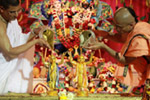 Krishna Janmashtami (Devanagari कृष्ण जन्माष्टमी), also known simply as Janmashtami
or Gokulashtami, is an annual Hindu festival that celebrates the birth of Krishna,
the eighth avatar of Vishnu. It is observed according to Hindu luni-solar calendar,
on the eighth day (Ashtami) of the Krishna Paksha (dark fortnight) in the month
of Shraavana of the Hindu Calendar, which overlaps with August and September of
the Gregorian calendar.
Krishna Janmashtami (Devanagari कृष्ण जन्माष्टमी), also known simply as Janmashtami
or Gokulashtami, is an annual Hindu festival that celebrates the birth of Krishna,
the eighth avatar of Vishnu. It is observed according to Hindu luni-solar calendar,
on the eighth day (Ashtami) of the Krishna Paksha (dark fortnight) in the month
of Shraavana of the Hindu Calendar, which overlaps with August and September of
the Gregorian calendar.
SEPTEMBER
ID-AL-ADHA (Bakreed) | Where: All over Bihar
 Eid-al-Adha, also called the "Sacrifice Feast", is the second of two Islamic holidays
celebrated worldwide each year, and considered the holier of the two. It honors
the willingness of Ibrahim (Abraham) to sacrifice his son, as an act of obedience
to God's command. Before Abraham sacrificed his son, God provided a male goat to
sacrifice instead. In commemoration of this, an animal is sacrificed and divided
into three parts: one third of the share is given to the poor and needy; another
third is given to relatives, friends and neighbors; and the remaining third is retained
by the family.
Eid-al-Adha, also called the "Sacrifice Feast", is the second of two Islamic holidays
celebrated worldwide each year, and considered the holier of the two. It honors
the willingness of Ibrahim (Abraham) to sacrifice his son, as an act of obedience
to God's command. Before Abraham sacrificed his son, God provided a male goat to
sacrifice instead. In commemoration of this, an animal is sacrificed and divided
into three parts: one third of the share is given to the poor and needy; another
third is given to relatives, friends and neighbors; and the remaining third is retained
by the family.
OCTOBER
MAHATMA GANDHI JAYANTI | When & Where: 02nd October | All over Bihar
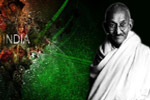 Gandhi Jayanti is a national festival celebrated in India to mark the occasion of
the birthday of Mohandas Karamchand Gandhi, who is also known as the "Father of
the Nation". It is celebrated on 2nd October. It is one of the four Public Holidays
in India. The United Nations General Assembly announced on 15 June 2007 that it
adopted a resolution which declared that 2 October will be celebrated as the International
Day of Non-Violence.
Gandhi Jayanti is a national festival celebrated in India to mark the occasion of
the birthday of Mohandas Karamchand Gandhi, who is also known as the "Father of
the Nation". It is celebrated on 2nd October. It is one of the four Public Holidays
in India. The United Nations General Assembly announced on 15 June 2007 that it
adopted a resolution which declared that 2 October will be celebrated as the International
Day of Non-Violence.
DURGA POOJA | Where: All over Bihar
 Durga Puja, also called Durgotsava, is an annual Hindu festival in the Indian subcontinent
that reveres the goddess Durga. It is particularly popular in West Bengal, Bihar,
Jharkhand, Odisha, Assam, Tripura, Bangladesh and the diaspora from this region,
and also in Nepal where it is called Dashain. The festival is observed in the Hindu
calendar month of Ashvin, typically September or October of the Gregorian calendar,
and is a multi-day festival that features elaborate temple and stage decorations
(pandals), scripture recitation, performance arts, revelry, and processions. It
is a major festival in the Shaktism tradition of Hinduism across India and Shakta
Hindu diaspora.
Durga Puja, also called Durgotsava, is an annual Hindu festival in the Indian subcontinent
that reveres the goddess Durga. It is particularly popular in West Bengal, Bihar,
Jharkhand, Odisha, Assam, Tripura, Bangladesh and the diaspora from this region,
and also in Nepal where it is called Dashain. The festival is observed in the Hindu
calendar month of Ashvin, typically September or October of the Gregorian calendar,
and is a multi-day festival that features elaborate temple and stage decorations
(pandals), scripture recitation, performance arts, revelry, and processions. It
is a major festival in the Shaktism tradition of Hinduism across India and Shakta
Hindu diaspora.
MUHARRAM | Where: All over Bihar
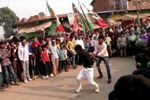 Muḥarram is the first month of the Islamic calendar. It is one of the four sacred
months of the year. It is held to be the holiest month, Ramadan coming after. The
word "Muharram" means "forbidden". Since the Islamic calendar is a lunar calendar,
Muharram moves from year to year when compared with the Gregorian calendar.
Muḥarram is the first month of the Islamic calendar. It is one of the four sacred
months of the year. It is held to be the holiest month, Ramadan coming after. The
word "Muharram" means "forbidden". Since the Islamic calendar is a lunar calendar,
Muharram moves from year to year when compared with the Gregorian calendar.
DEEPAWALI | Where: All over Bihar
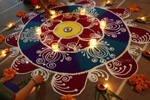 Diwali or Deepavali is the Hindu festival of lights celebrated every year in autumn
in the northern hemisphere (spring in southern hemisphere). One of the most popular
festivals of Hinduism, it spiritually signifies the victory of light over darkness,
good over evil, knowledge over ignorance, and hope over despair. Its celebration
includes millions of lights shining on housetops, outside doors and windows, around
temples and other buildings in the communities and countries where it is observed.
The festival preparations and rituals typically extend over four to six day period.
The word Diwali is used by some communities to mean all the festivities while others
think of it as one festival night on the no moon day of the Hindu Lunisolar month
Kartika in Bikram Sambat calendar (the month of Aippasi in Tamil Calendar). In the
Gregorian calendar, Diwali falls in mid-October and mid-November.
Diwali or Deepavali is the Hindu festival of lights celebrated every year in autumn
in the northern hemisphere (spring in southern hemisphere). One of the most popular
festivals of Hinduism, it spiritually signifies the victory of light over darkness,
good over evil, knowledge over ignorance, and hope over despair. Its celebration
includes millions of lights shining on housetops, outside doors and windows, around
temples and other buildings in the communities and countries where it is observed.
The festival preparations and rituals typically extend over four to six day period.
The word Diwali is used by some communities to mean all the festivities while others
think of it as one festival night on the no moon day of the Hindu Lunisolar month
Kartika in Bikram Sambat calendar (the month of Aippasi in Tamil Calendar). In the
Gregorian calendar, Diwali falls in mid-October and mid-November.
NOVEMBER
CHITRAGUPTA POOJA/BHAI DOOJ | Where: All over Bihar
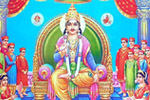 Every year, a day after the festival of lights Diwali, Kayastha’s all over the world
celebrate Chitragupta Puja also known as Kalam-Dawaat Puja. This festival falls
on the second day of the lunar day of Shukla Paksha in the Vikram Samvat calendar
month of Kartik and coincides with Bhai Dooj, Bhau Beej, Bhai Phota or Bhai Teeka.
Devotees believe that by doing this puja they will be benefited and get to ascend
to heaven as Chitragupta Maharaj keeps a record of all good and evil deeds of humans
and by praying to him on this day they get absolution from all the sins. Upon the
death of a human being, it is Chitragupta Maharaj who decides on heaven or hell
for the person depending on their good work or bad deeds on earth.
Every year, a day after the festival of lights Diwali, Kayastha’s all over the world
celebrate Chitragupta Puja also known as Kalam-Dawaat Puja. This festival falls
on the second day of the lunar day of Shukla Paksha in the Vikram Samvat calendar
month of Kartik and coincides with Bhai Dooj, Bhau Beej, Bhai Phota or Bhai Teeka.
Devotees believe that by doing this puja they will be benefited and get to ascend
to heaven as Chitragupta Maharaj keeps a record of all good and evil deeds of humans
and by praying to him on this day they get absolution from all the sins. Upon the
death of a human being, it is Chitragupta Maharaj who decides on heaven or hell
for the person depending on their good work or bad deeds on earth.
Bhai Dooj(भाई दूज) / Bhau-Beej / Bhai Tika / Bhai Phonta is a festival celebrated
by Hindus of India and Nepal on the second lunar day of Shukla Paksha (bright fortnight)
in the Vikram Samvat Hindu calendar month of Kartika. It is celebrated during the
Diwali or Tihar festival.
CHHATH POOJA | Where: All over Bihar
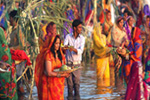 The Chhath is an ancient Hindu Vedic festival historically
native to Nepal and Indian states of Bihar, Jharkhand and Uttar Pradesh. The Chhath
Puja is dedicated to the Sun and his wife Usha in order to thank them for bestowing
the bounties of life on earth and to request the granting of certain wishes. Chhath
does not involve any idol worship. This festival is observed by Nepalese and Indian
people, along with their diaspora. While it is a Hindu festival, some Muslims also
celebrate Chhath.
The Chhath is an ancient Hindu Vedic festival historically
native to Nepal and Indian states of Bihar, Jharkhand and Uttar Pradesh. The Chhath
Puja is dedicated to the Sun and his wife Usha in order to thank them for bestowing
the bounties of life on earth and to request the granting of certain wishes. Chhath
does not involve any idol worship. This festival is observed by Nepalese and Indian
people, along with their diaspora. While it is a Hindu festival, some Muslims also
celebrate Chhath.
CHEHALLUM | Where: All over Bihar
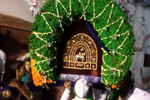 Arba'een, Chehllum is a Shia Muslim religious observance that occurs forty days
after the Day of Ashura. It commemorates the martyrdom of Husayn ibn Ali, the grandson
of the Islamic prophet Muhammad, who was killed on the 10th day of the month of
Muharram. Imam Husayn ibn Ali and 72 companions were killed by Yazid I's army in
the Battle of Karbala in 61 AH (680 CE). Writing in forty batches[clarification
needed] has become a tradition among Islamic scholars.
Arba'een, Chehllum is a Shia Muslim religious observance that occurs forty days
after the Day of Ashura. It commemorates the martyrdom of Husayn ibn Ali, the grandson
of the Islamic prophet Muhammad, who was killed on the 10th day of the month of
Muharram. Imam Husayn ibn Ali and 72 companions were killed by Yazid I's army in
the Battle of Karbala in 61 AH (680 CE). Writing in forty batches[clarification
needed] has become a tradition among Islamic scholars.
DECEMBER
HAJRAT MOHAMMAD SAHAB'S BIRTHDAY | Where: All over Bihar
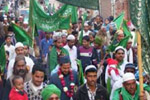 Sunni Muslims observe the Prophet Muhammed's (also known as Mohammed or Muhammad)
birthday on the 12th day of the Islamic month of Rabi' al-awwal, while Shi'a Muslims
mark it on the 17th of this month. Muhammed is believed to be the last prophet.
Sunni Muslims observe the Prophet Muhammed's (also known as Mohammed or Muhammad)
birthday on the 12th day of the Islamic month of Rabi' al-awwal, while Shi'a Muslims
mark it on the 17th of this month. Muhammed is believed to be the last prophet.
CHRISTMAS DAY | When & Where: 25th December | All over Bihar
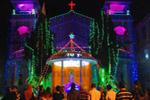 The Christmas is an annual festival commemorating the birth
of Jesus Christ, observed primarily on December 25 as a religious and cultural celebration
among billions of people around the world. A feast central to the Christian liturgical
year, it is preceded by the season of Advent or the Nativity Fast and initiates
the season of Christmastide, which historically in the West lasts twelve days and
culminates on Twelfth Night; in some traditions, Christmastide includes an octave.
Christmas Day is a public holiday in many of the world's nations, is celebrated
religiously by a majority of Christians, as well as culturally by many non-Christians,
and forms an integral part of the holiday season centered around it.
The Christmas is an annual festival commemorating the birth
of Jesus Christ, observed primarily on December 25 as a religious and cultural celebration
among billions of people around the world. A feast central to the Christian liturgical
year, it is preceded by the season of Advent or the Nativity Fast and initiates
the season of Christmastide, which historically in the West lasts twelve days and
culminates on Twelfth Night; in some traditions, Christmastide includes an octave.
Christmas Day is a public holiday in many of the world's nations, is celebrated
religiously by a majority of Christians, as well as culturally by many non-Christians,
and forms an integral part of the holiday season centered around it.

